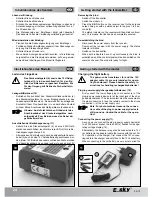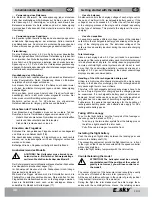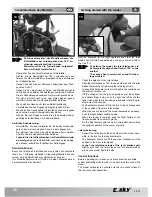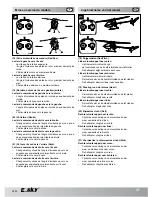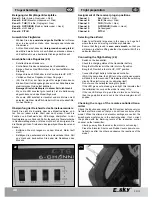
05/10
30
Inbetriebnahme des Modells
Getting started with the model
Verwendung eines Balancers
Ein Balancer überwacht die Ladespannung jeder einzelnen
Zelle (bei mehrzelligen LiPo-Akkupacks). Sollte an einer Zelle
die Spannung 4,2 V übersteigen, so wird je nach Bauart des
Balancers entweder die Zelle entladen oder der Ladevorgang
der einzelnen Zelle beendet. Dies sichert die einzelne Zelle vor
Überladung.
Verwendung eines Equalizers
Ein Equalizer gleicht bereits zu Beginn des Ladevorgangs unter-
schiedliche Spannungslagen der einzelnen Zellen innerhalb
des Akkupacks aus. Somit sind die einzelnen Spannungen der
Zellen während des ganzen Ladevorgangs absolut identisch.
Tiefentladung
Da eine Entladung unter 2,5 V pro Zelle zu einer dauerhaften
Schädigung des Akkus führt, ist diese Tiefentladung in jeden Fall
zu vermeiden. Aus Sicherheitsgründen sollten Sie programmier-
bare Fahrt- und Flugregler so einstellen, dass bereits bei einer
Spannung von 3,0 V pro Zelle die Unterspannungserkennung
anspricht. Alternativ dazu sind optische Unterspannungsanzeigen
ebenfalls sehr empfehlenswert.
Handhabung des LiPo-Akkus
Lithium ist ein sehr reaktionsfreudiges chemisches Element mit
hoher Energiedichte. Durch Überladung können LiPo-Akkus
zerplatzen oder sich sogar entzünden.
Aus diesem Grund müssen Sie LiPo-Akkus zum Laden immer
auf einen feuerfesten Untergrund legen und den Ladevorgang
beaufsichtigen.
Wird ein Akku durch einen Absturz oder Crash verformt oder
beschädigt, darf er nicht mehr weiter eingesetzt werden. Der
Akku muss vorschriftsmäßig entsorgt werden.
Weiterhin gelten auch für LiPo-Akkus die allgemeinen
Gefahrenhinweise im Umgang mit Akkus und Batterien.
Abnehmen der Trainerhaube
Zum Einsetzen des Flugakkus muss nur der vordere Teil des
Rumpfes, bzw. die Trainerhaube abgenommen werden (14).
Hebeln Sie dazu die beiden Gummiösen von den Haltestiften
rechts und links unterhalb des Rotorkopfes .
Ziehen Sie die Haube nach vorne ab.
Einsetzen des Flugakkus
Schieben Sie den geladenen Flugakku zwischen Landegestell
und Motor in den Akkuschacht (
15)
.
Die Anschlusskabel müssen in Flugrichtung vorn nach rechts
weisen, um verspannungsfrei mit dem Flugregler verbunden
werden zu können.
Befestigen Sie den Flugakku vorläufig mit dem Klettband.
Ausbalancieren des Modells
ACHTUNG! Der Helikopter muss korrekt aus-
balanciert sein. Bei falscher Schwerpunktlage
verlieren Sie die Kontrolle über das Modell!
Der Schwerpunkt des Heli-Modells sollte exakt auf der Drehachse
des Hauptrotors (Hochachse) liegen (16).
Im Schwerpunkt kreuzen sich alle Drehachsen (Hoch-/Längs-
Querachse) des Modells (a).
Während des Fluges müssen sich die Rotorblätter durch die
Fliehkraft von selbst ausrichten können. Darum dürfen für den
Flugbetrieb die Halteschrauben nur so fest angezogen werden,
dass die Rotorblätter noch nach unten abklappen können,
sobald Sie Ihr Modell zur Seite kippen (17).
-
-
-
-
Use of a balancer
A balancer monitors the charging voltage of each single cell (in
the case of multi-cell LiPo rechargeable battery packs). If the
voltage at one cell exceeds 4.2 V, either the cell is discharged
or the charging process of the single cell is stopped, depending
on the type of balancer. This protects the single cell from over-
charging.
Use of an equalizer
An equalizer equalises different voltage levels of the individual
cells within the rechargeable battery pack already at the begin-
ning of the charging process. The individual voltages of the
cells are thus absolutely identical during the complete charging
process.
Total discharge
Since a discharging below 2.5 V per cell leads to a permanent
damaging of the rechargeable battery pack, this total discharging
is to be prevented at any rate. For safety reasons, programmab-
le cruise controls/flight control systems should be set in such
a way that the undervoltage detection responds already at a
voltage of 3.0 V per cell. Alternatively, the optical undervoltage
displays are also recommendable.
Handling of the LiPo rechargeable battery pack
Lithium is a highly reactive chemical element with a high energy
density. In the case of overcharging, the LiPo rechargeable bat-
tery packs might burst or even inflame.
Therefore, LiPo rechargeable battery packs always have to be
put on a fire-proof ground for charging and the charging process
be supervised. If a rechargeable battery pack is deformed or
damaged, it must not be used any longer. The rechargeable bat-
tery pack has to be disposed of according to regulations.
Furthermore, the general danger warnings for the handling of
rechargeable battery packs and batteries also apply for LiPo
rechargeable battery packs.
Taking off the canopy
To put in the flight battery, only the front part of the fuselage or
the canopy has to be taken off (14).
To do so, pry the two rubber eyelets from the holding pins on
the left and right beneath the rotor head.
Pull off the cabin, doing so toward the front.
Installing the flight battery
Push the charged flight battery between the landing gear and
motor in the battery shaft (15).
The connecting cable must point in the flight direction, i.e. in front
to the right, so that it can be connected with the speed controller
without any distortion.
Fasten the flight battery temporarily with the Velcro strap.
Counterbalancing the model
ATTENTION! The helicopter must be correctly
counterbalanced. If the position of the center of
gravity is not correct, you will lose control over
the model!
The center of gravity of the helicopter model should be exactly
on the axis of rotation of the main rotor (yaw axis) (16).
All the axes of rotation will cross in the center of gravity (vertical
/ longitudinal / lateral axis) of the model (a).
During the flight, the rotor blades must be able to align them-
selves with the centrifugal force. Hence, the retaining screws
-
-
-
-









